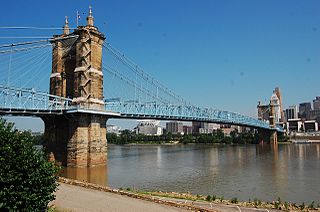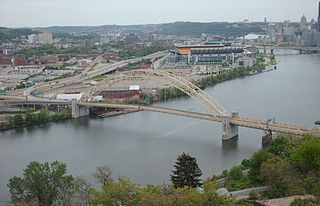
Newport is a home rule-class city at the confluence of the Ohio and Licking rivers in Campbell County, Kentucky, United States. The population was 14,150 at the 2020 census. Historically, it was one of four county seats of Campbell County. Newport is a major urban center of Northern Kentucky and is part of the Cincinnati metropolitan area.

The John A. Roebling Suspension Bridge is a suspension bridge that spans the Ohio River between Cincinnati, Ohio, and Covington, Kentucky. When opened on December 1, 1866, it was the longest suspension bridge in the world at 1,057 feet (322 m) main span, which was later overtaken by John A. Roebling's most famous design of the 1883 Brooklyn Bridge at 1,595.5 feet (486.3 m). Pedestrians use the bridge to get between the hotels, bars, restaurants, and parking lots in Northern Kentucky. The bar and restaurant district at the foot of the bridge on the Kentucky side is known as Roebling Point.

Interstate 471 (I-471) is a 5.75-mile-long (9.25 km) Interstate Highway, linking I-71 in Downtown Cincinnati, Ohio, to I-275 in Highland Heights, Kentucky. South of I-275, the expressway continues south to U.S. Route 27 (US 27) as unsigned Kentucky Route 471 (KY 471).

The Smithfield Street Bridge is a lenticular truss bridge crossing the Monongahela River in Pittsburgh, Pennsylvania, USA.

The Daniel Carter Beard Bridge, is a yellow twin span steel bowstring arch bridge crossing the Ohio River in Cincinnati, Ohio. It carries Interstate 471 between Cincinnati, Ohio, and Newport, Kentucky. As to the origin of this nickname, its yellow arches are said to be similar to the "Golden Arches" logo of McDonald's restaurant. The nickname was coined by local residents after the bridge's golden arches were constructed. In the 1980s, McDonald's considered opening a floating restaurant at the base after the nickname caught on, but never went to construction. This bridge has a main span of 750 feet (230 m) and has a total span of 2,100 feet (640 m). It is named in honor of Daniel Carter Beard, the founder of the Sons of Daniel Boone and one of the founders of the Boy Scouts of America.

The Purple People Bridge is a pedestrian-only bridge that stretches 2,670 feet over the Ohio River, connecting Newport, Kentucky to downtown Cincinnati, Ohio.

The U.S. Grant Bridge is the name of the two bridges that carry and have carried traffic on U.S. Route 23 between Portsmouth, Ohio and South Portsmouth, Kentucky across the Ohio River in the United States. The original suspension bridge was closed and demolished in 2001 and the replacement cable-stayed bridge opened on October 16, 2006.

The Clay Wade Bailey Bridge is a cantilever bridge carrying U.S. Route 42 and U.S. Route 127 across the Ohio River, connecting Cincinnati, Ohio and Covington, Kentucky. This also marks the termination of U.S. Route 25. The bridge's main span is 675 feet (206 m). It is a 3-lane bridge; Two lanes are dedicated to travel each way and the middle lane is a reversible lane, meaning the direction of travel of the middle lane changes according to the time of day.

The Combs–Hehl Bridge is a twin span single pier cantilever bridge carrying Interstate 275 (I-275) across the Ohio River. It connects the Eastern portion of Cincinnati, Ohio and Campbell County, Kentucky.

The High Bridge is a railroad bridge crossing the Kentucky River Palisades, that rises approximately 275 feet from the river below and connects Jessamine and Mercer counties in Kentucky. Formally dedicated in 1879, it is the first cantilever bridge constructed in the United States. It has a three-span continuous under-deck truss used by Norfolk Southern Railway to carry trains between Lexington and Danville. It has been designated as a National Historic Civil Engineering Landmark.

The Big Four Bridge is a six-span former railroad truss bridge that crosses the Ohio River, connecting Louisville, Kentucky, and Jeffersonville, Indiana. It was completed in 1895, updated in 1929, taken out of rail service in 1968, and converted to bicycle and pedestrian use in 2014. The largest single span is 547 feet (167 m), with the entire bridge spanning 2,525 feet (770 m). It took its name from the defunct Cleveland, Cincinnati, Chicago and St. Louis Railway, which was nicknamed the "Big Four Railroad".

The C&O Railroad bridge is a cantilever truss bridge carrying the CSX Transportation Cincinnati Terminal Subdivision over the Ohio River. It was the first railroad bridge connecting Cincinnati, Ohio, and Covington, Kentucky.

The Cincinnati Southern Bridge, originally the Cincinnati Southern Railroad Swinging Truss Bridge, is a vertical lift bridge that carries the Norfolk Southern Railway's Cincinnati, New Orleans and Texas Pacific Railway over the Ohio River between Cincinnati, Ohio, and Ludlow, Kentucky in the United States.

The West End Bridge is a steel tied-arch bridge over the Ohio River in Pittsburgh, Pennsylvania, approximately 1 mile (1.6 km) below the confluence of the Allegheny and Monongahela Rivers. It connects the West End to the Chateau neighborhood on the North Side of Pittsburgh.

The Milton–Madison Bridge is a continuous truss bridge that connects Milton, Kentucky and Madison, Indiana. It carries approximately 10,000 cars a day. The old structure was replaced with a completely new continuous truss which was constructed on temporary piers adjacent to the operational span between 2011 and 2012 and slid into place after demolition of the old span using a construction method called "truss sliding." The new crossing opened to vehicle traffic in April 2014, and a pedestrian sidewalk opened that October.

A continuous truss bridge is a truss bridge that extends without hinges or joints across three or more supports. A continuous truss bridge may use less material than a series of simple trusses because a continuous truss distributes live loads across all the spans; in a series of simple trusses, each truss must be capable of supporting the entire load.

The Cincinnati–Newport Bridge, also known as the Central Bridge, was a cantilever bridge which crossed the Ohio River between Newport, Kentucky, and Cincinnati, Ohio. It was completed in 1890 and demolished in 1992 to make way for the Taylor–Southgate Bridge, which opened in 1995.

The Fourteenth Street Bridge, also known as the Ohio Falls Bridge, Pennsylvania Railroad Bridge, Conrail Railroad Bridge or Louisville and Indiana (L&I) Bridge, is a truss drawbridge that spans the Ohio River, between Louisville, Kentucky and Clarksville, Indiana.

Transportation in Cincinnati includes sidewalks, roads, public transit, bicycle paths, and regional and international airports. Most trips are made by car, with transit and bicycles having a relatively low share of total trips; in a region of just over 2 million people, less than 80,000 trips are made with transit on an average day. The city is sliced by three major interstate highways, I-71, I-74 and I-75, and circled by a beltway several miles out from the city limits. The region is served by two separate transit systems, one on each side of the river. SORTA, on the Ohio side is about six times larger than TANK on the Kentucky side.

The Dongshuimen Bridge and the Qiansimen Bridge, known collectively as the Twin River Bridges, are a pair of bridges that form a road and rail connection in Chongqing, China. Consisting of two cable-stayed bridges and a tunnel across the Yuzhong peninsula where the heart of Chongqing's commercial & financial district Jiefangbei CBD is located, the connection opened in 2014.






















